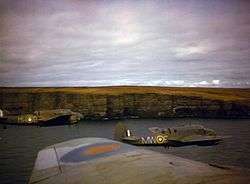No. 217 Squadron RAF
| No. 217 Squadron RAF | |
|---|---|
|
Bristol Beauforts of No. 217 Squadron off Cornwall, 1942 | |
| Active | 1918 - 1919, 1937-1945, 1952-1957, 1958-1959 |
| Country | United Kingdom |
| Branch | Royal Air Force |
| Role | General Reconnaissance |
| Part of | RAF Coastal Command |
| Motto(s) | Woe to the unwary |
| Engagements | World War I, World War II, Operation Grapple |
No. 217 Squadron RAF was originally formed on 1 April 1918, from the No. 17 Naval Squadron at Bergues, near Dunkerque.[1] It conducted daylight raids using Airco DH.4s on enemy bases and airfields in Belgium. The squadron was disbanded on 18 October 1919, after the end of World War I.
World War II
No. 217 Squadron was re-formed by Coastal Command of the Royal Air Force on 15 March 1937 at Boscombe Down, equipped with Avro Ansons, performing general reconnaissance duties until the start of World War II, when it moved to the newly built airfield RAF St Eval, conducting coastal patrols until October 1939. From May 1940, it was equipped with the Bristol Beaufort torpedo bomber, but because of problems with its Taurus engines, the Ansons remained in service until December 1940.
The squadron was ordered to Ceylon, via Gibraltar and Malta, in May 1942.[2] En route, it conducted anti-shipping and mine-laying attacks for two months in the Mediterranean. In one incident, on 28 June 1942, the crew of a ditched Beaufort were rescued by an Italian CANT Z.506 seaplane. The Italian crew were overpowered and the Cant was flown to Malta where the Italians were made prisoners of war.[3] Crew losses were quite severe, with the remainder of the force arriving in Ceylon in July, with the ground echelon arriving by sea in August.
On 15 March 1937, No.217 reformed as a general reconnaissance squadron at Boscombe Down equipped with Ansons. On the outbreak of World War Two, it took up its station and bagan flying patrols over the western approaches to the English Channel. For the next two years it was based at St.Eval which it occupied in an unfinished state in October 1939. In May 1940 No.217 began to receive Beauforts but teething troubles prevented these from being used operationally until 25 September and the Ansons did not end their patrols until December. The Beauforts concentrated on attacks on enemy shipping and minelaying until transferred to Ceylon in May. The aircraft flew out via Gibraltar and Malta where they spent two months attacking enemy shipping in the Mediterranean.
The ground echelon arrived in Ceylon in August where it received Hudsons for anti-submarine patrols, the Beauforts having been retained in the Middle East. New Beauforts began to arrive in April 1943, and by July the squadron had reverted to a strike unit, re-equipping with Beaufighters in July 1944. The Japanese made no further attempts to attack Ceylon and No.217 spent its time defensively until May 1945, when it was posted to Cocos Island to prepare for invasion in Malaya. This was forestalled by the Japanese surrender and the squadrons aircraft never did get to Coco's remaining in Ceylon until disbanded on 30 September 1945.
Post World War II
No. 217 Squadron re-formed once again on 14 January 1952 as a Maritime Reconnaissance Squadron, trialling two Lockheed Neptune MR Mark 1s[4] at RAF St Eval, then moving their base of operations to RAF Kinloss in April, being fully equipped with Neptunes by July that year. The squadron disbanded again on 31 March 1957.
Operation Grapple
The last brief re-formation of No. 217 Squadron out of No. 1630 Flight was from 1 February 1958 until 13 November 1959, when it flew Westland Whirlwind HAR Mark 2 helicopters, as part of the air support for the British hydrogen bomb tests on Christmas Island in the Pacific, codenamed Operation Grapple.
Squadron motto: Woe to the unwary
Squadron badge: A demi-shark erased
References
- ↑ See external link "History of No. 217 Squadron".
- ↑ See external link "No. 217 Squadron RAF".
- ↑ "CHRONOLOGY OF THE SIEGE OF MALTA, 1940-43". Merlins over Malta.
- ↑ See external link "No. 216 - 220 Squadron Histories".
External links
| Wikimedia Commons has media related to No. 217 Squadron RAF. |
- "No. 217 Squadron RAF". Coastal Command Index.
- "History of No. 217 Squadron". Royal Air Force History.
- "No. 217 Squadron: Planned One-Way Missions". Library Ref 019, Aircrew Association, Scottish Saltaire Branch.
- "Flying with 22 and 217 Squadrons, RAF". Library Ref 154, Aircrew Association, Scottish Saltaire Branch.
- "No. 216 - 220 Squadron Histories". Air of Authority - A History of RAF Organisation.
